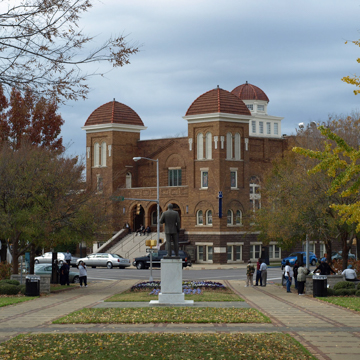Sixteenth Street Baptist Church is an architectural landmark and important civil rights site. Originally known as the First Colored Baptist Church of Birmingham, this was the first African American church founded in Birmingham, less than two years after the city was incorporated in 1871. A decade and a half later, the congregation had built an impressive Gothic Revival structure on the site of the current church, kitty-corner from Kelly Ingram Park, one of three parks created when the city was laid out. After structural issues necessitated that building’s demolition, the congregation turned to local Black architect Wallace A. Rayfield to design a replacement. Rayfield had come to Birmingham two years before, after a stint at Tuskegee Institute, where Booker T. Washington had invited him to teach.
The variegated brown brick structure stands on a raised basement of dark brown rock-faced sandstone. Bold bell towers with arched pyramidal roofs flank a slightly recessed and finely articulated midsection; the whole composition is the essence of symmetry and balance. A wide flight of steps rises to the deep, arcaded loggia marking the entry. Holding the composition together, above the loggia, is a broad pediment form in brick, with a blind arch that echoes the arched openings below, and a prominent two-tiered domed cupola marking the central crossing of the transepts and the nave. Raised brick defines alternating rows of banding and arched, circular, and rectangular moldings that enrich the facade with contrasting light and shadow. Limestone sills, lintels, and stringcourse add unifying horizontal accents. Stained glass windows are primarily opalescent glass.
In the 1960s, Sixteenth Street Baptist Church became associated with the struggle for civil rights, receiving national attention during the Birmingham Campaign in the spring of 1963 and the bombing that followed in September. In the segregated South, churches and pastors were powerful forces in the Black community, the nexus for political and social action as well as worship. In 1956, the Reverend Fred Shuttlesworth, pastor of Bethel Baptist Church in the Collegeville section of Birmingham, founded the Alabama Christian Movement for Human Rights (ACMHR), which assumed leadership of civil rights efforts in Birmingham after the NAACP was banned from the state. Shuttlesworth introduced weekly mass meetings that rotated among participating churches, priming efforts to desegregate Birmingham’s public facilities and to open opportunities for employment. Even after a number of years, lawsuits, boycotts, and direct nonviolent action yielded little more than continuing tension, threats, and violent attacks.
Early in 1963, Shuttlesworth sought outside help and met with Dr. Martin Luther King Jr. and other members of the Southern Christian Leadership Conference to plan the Birmingham Campaign. They launched a series of nonviolent protests throughout the spring. Sixteenth Street Baptist Church, because of its capacious size and convenient location across from Kelly Ingram Park and just blocks from the heart of the city’s segregated retail district and public institutions, became a staging area for the daily marches (along with the park itself). In early May, local school students launched the Children’s Crusade, skipping school to march against segregation. They were arrested by the hundreds and soon overwhelmed Birmingham’s jails. Riveting photographs of firehoses and attacking police dogs shocked the nation and the world. A truce was announced on May 10, but violence continued sporadically. On Sunday, September 15, members of a group affiliated with the Ku Klux Klan set off a dynamite blast that ripped open the side of the church and killed four young girls who were attending Sunday school. The bombing gave major impetus to passage of the Civil Rights Act of 1964.
After the 1963 bombing, the church building committee selected Birmingham architects Nelson Smith and Stanley B. Echols and contractor Leroy S. Gaillard Jr. to complete the necessary repairs and reconstruction. The metal stairs and landing at the north end of the east side of the church, under which the bomb was planted, were not replaced; a double-hung window and bricks filled the opening where a door had been. Basement windows and the part of the foundation blown out by the blast were replaced, except where a metal door and awning were substituted for the original fittings. Damaged stained glass windows were replaced to match the originals, except for a window installed in 1965. A gift from the people of Wales and designed by Welsh artist John Petts, this stained glass representation of a Black Christ replaced the central window on the front elevation. Basement interior renovations included the addition of rooms along the east and west walls and a memorial room on the south end. Contributions came from around the world to help fund the work. The church reopened for its first service after the bombing on June 7, 1964.
In recent decades, the church’s setting has evolved to offer a fuller interpretive context. Kelly Ingram Park is filled with statues by distinguished sculptors commemorating events associated with civil rights history. Across the street from the church and the park stands the Birmingham Civil Rights Institute, a cultural and educational research center that tells the Birmingham civil rights story. Sixteenth Street Baptist Church was designated a National Historic Landmark in 2006, and stands as a powerful physical reminder of a pivotal moment in American history.
References
Dolinsky, Paul D., Joseph Balachowski, and Catherine C. Lavoie, “Sixteenth Street Baptist Church,” Jefferson County, Alabama. Historic American Buildings Survey (HABS No. AL-898), 1993. National Park Service, U.S. Department of the Interior, Washington, D.C.
Durough, Allen R. The Architectural Legacy of Wallace A. Rayfield. Tuscaloosa: University of Alabama Press, 2010.
Fallin, Wilson, Jr. The African American Church in Birmingham, Alabama, 1815–1963: A Shelter in the Storm. New York: Garland Publishing, 1997.
Schnorrenberg, John M. Aspiration: Birmingham’s Historic Houses of Worship. Birmingham, AL: Birmingham Historical Society, 2000.
Spinks, Amy A., “Sixteenth Street Baptist Church,” Jefferson County, Alabama. National Historic Landmark Nomination Form, 2004. National Park Service, U.S. Department of the Interior, Washington, D.C.














